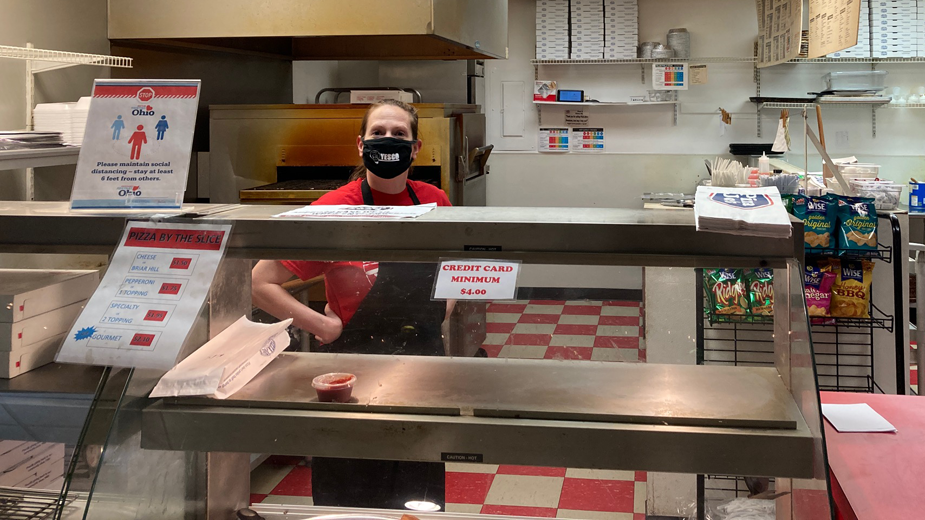Delivery Apps Take Bite Out of Restaurant Profits
YOUNGSTOWN, Ohio – With the pandemic stifling their dine-in business, many restaurants are now offering delivery in an attempt to find a new COVID-safe revenue stream. But delivery services are taking a big bite of the profits.
Most chain eateries have signed up with the big app-based deliverers, such as DoorDash, Grubhub and UberEats, to carry food to their customers. Some locally owned restaurants have also jumped on board, although they are fewer in number because of the hefty fee.
App companies take between 20% and 30% of the bill. In a field where profit margins hover in the single digits, that big of a cut makes it hard to turn a profit. However, relief measures are being enacted in Ohio’s three largest cities, and more may follow suit.
City councils in Cincinnati and Columbus have enacted laws that temporarily – and sharply – reduce the percentage that delivery services can charge restaurants, said John Barker, president of the Ohio Restaurant Association. Cleveland City Council was to vote this week on a measure that would cap the delivery service share at 15%.
The laws will remain in effect until 90 days after Gov. Mike DeWine lifts restrictions on restaurant capacity and rescinds the 10 p.m. curfew, Barker said. After that, the apps’ share will revert to their prepandemic levels.
“We may learn a lot between now and then, and find out the apps are willing to keep [the percentage] there, but that’s yet to be determined,” Barker said.
With the rate caps in place in Ohio’s major cities, Barker said he believes “other cities and counties will use the template to negotiate.”
Such a measure has not yet been on the agenda of Youngstown City Council or the Mahoning County Commissioners.
Restaurants across the state need all the help they can get at this time, Barker said.
“The governments in those three cities are saying, ‘We’re in an emergency and this industry is in a crisis,’” Barker said.
He broke down the numbers to demonstrate the situation.
“If a restaurant sells a sandwich for $10, they might have to send [the delivery service] $3,” Barker said. “The profit margin for most restaurants is 6% to 7%, so in many cases you are losing money. It’s not sustainable.”
Batoul Jaafar, owner of the Capitol Grill in 20 Federal Place in downtown Youngstown signed up with DoorDash in late June, right after her lunch business reopened following the initial statewide shutdown of restaurants. She thought it would be a good way to reach her customers but wound up canceling the service shortly thereafter.
“We didn’t get a lot of calls and we thought the rate was too high,” she said. DoorDash charged her 20% of the receipt.
The app companies provide each restaurant with a smart tablet to key in each order. Information about the order is then sent to its closest – or most qualified – on-duty driver in the area, to pick up the food and deliver it. If the first driver does not accept the delivery, the message is then sent to other drivers. The delivery service then adds up its collected fees and pays its drivers their share on a weekly or daily basis.
One local operator has already been able to get a lower rate from DoorDash.
Aleen LaRocca, who owns the Pizza Joe’s location in 20 Federal Place, has had a delivery service since before the pandemic and teamed up with other franchisees of the chain to negotiate a lower rate.
“It’s worth it because it means I don’t have to hire a driver,” she said, noting that she would also have to pay insurance on the driver.
“We only get a handful of calls a week for delivery, but we also have shortened hours now, 11 a.m. to 3 p.m., because of COVID,” LaRocca said.
Jack Kravitz, owner of Kravitz Deli in Liberty Township, signed the restaurant up with Grubhub more than a year ago.His payment to the delivery service eats up most of the profit but he has no plans to drop it.
“By the time you are through with them, they take almost a third [of the receipt],” Kravitz said. “[Our costs] are around 60% [of the price of an order] and they take the other third.”
Kravitz Deli, 3135 Belmont Ave., is mainly a takeout shop. “If delivery was 50% of our business, that would be different,” Kravitz said. “But it tends to be only around 5% to 10%. It’s just some extra sales.”
Pictured: Aleen LaRocca stands behind the counter at her Pizza Joe’s shop in downtown Youngstown. LaRocca has teamed up with other franchisees in the pizza chain to negotiate a better rate for delivery services.
Copyright 2024 The Business Journal, Youngstown, Ohio.



